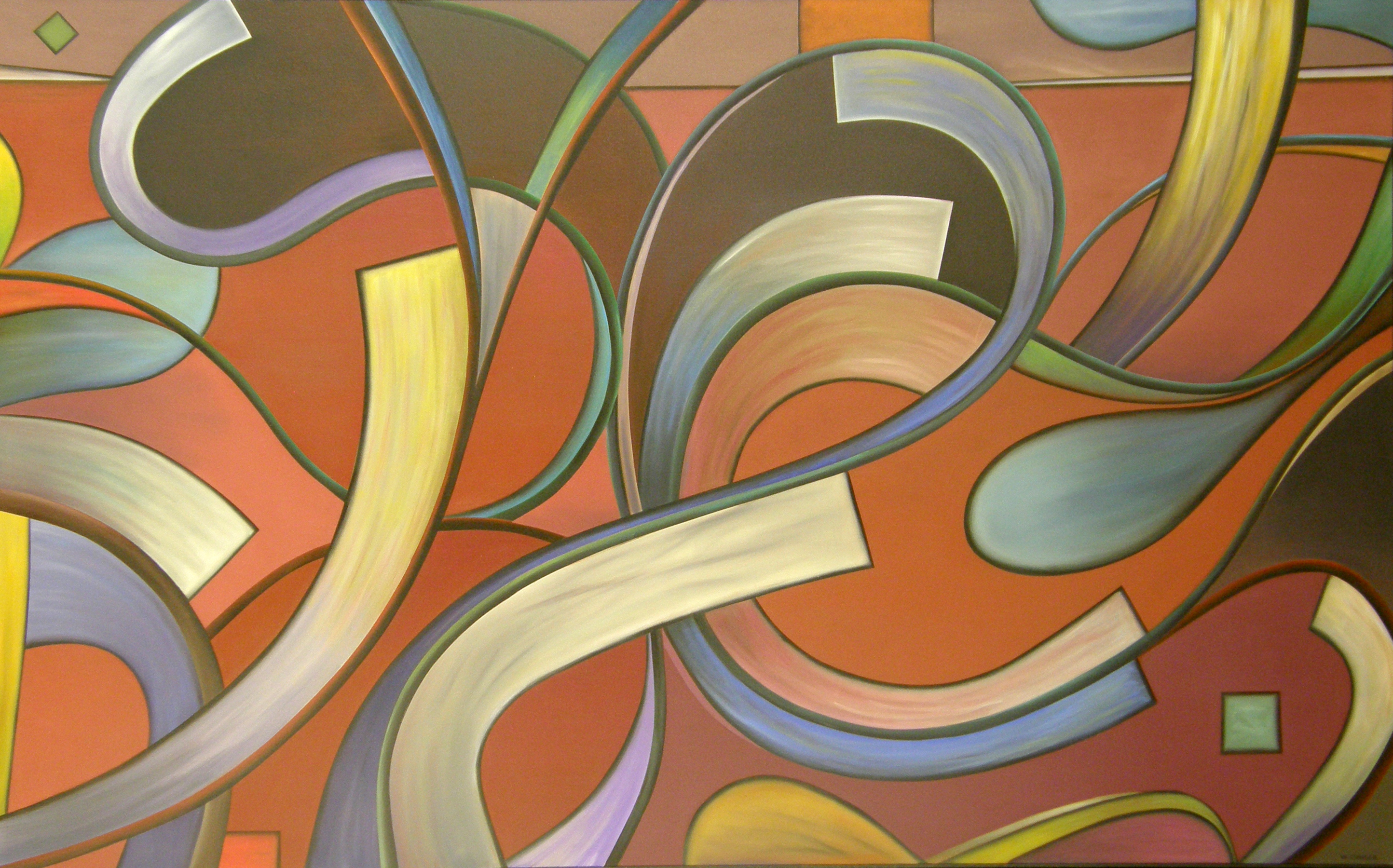- William Conger: Art Commentary by Gregg Hertzlieb

William Conger (b. 1937)
Kabuki, 2008
Oil on Canvas, 60 x 96 inches
Byron Lee and Josephine Luecke Ferguson Museum Acquisition Fund
Brauer Museum of Art, 2013.21
A new addition to the Brauer Museum of Art’s permanent collection is Kabuki, an oil on canvas painting by the Chicago abstract artist William Conger. The Byron Lee and Josephine Luecke Ferguson Museum Acquisition Fund generously provided the funds for the Brauer to acquire this recent work by a painter recognized as one of the finest working in Chicago today.For many years a professor of art at Northwestern University in Evanston, Conger influenced countless students with his remarkable technique, compositions, and rich color. Museums nationally and internationally have shared his works with the public, works that are accessible and formally pleasing but at the same time complex in their references and interplay of formal and conceptual aspects.
Chicago is perhaps best known in art historical terms for a figural style of art known as Imagism, originating in the 1960s in the work of a group of artists centered around the School of the Art Institute. Imagism combined quotations of popular culture, comic books and advertisements for example, with imagery derived from the artists’ lives and imaginations; Imagists as well were inspired by Outsider Art and non-Western art of various kinds. The meticulous execution that characterizes Imagist pieces offers a potent contrast to the whimsical, enigmatic, grotesque narratives that inhabit their works. A number of the founding Imagists are alive today, making objects that reflect their even greater refinement of their technique and continued playful investigations of their psyches. In addition, beginning artists continue to be influenced stylistically by the art of the Imagists, even though these new artists filter such sensibilities through 21st century concerns.
Chicago has a tradition of abstract art, as well, although the peculiar and innovative nature of Imagism allowed it to assume center stage. What makes Conger stand out so delightfully is his approach to abstraction that blends artful manipulation of color and shape with space, narrative, and seamless technique. Conger’s paintings dazzle with their flawless surfaces that would please any Imagist, and too he offers enough suggestion of pictorial space and shadow to communicate the idea of his ribbon-like subjects as existing within a realm, as opposed to just on the surface of the canvas. Through clear delineation of the aforementioned ribbons or shrouds, as well as shading within those shapes and in the background, Conger gives a glimpse of a fantastic landscape where laws of space and light seem to exist roughly comparable to this world; what emerges from Conger’s art, then, is a place that viewers can inhabit to both draw connections with the real and enjoy the artist’s considerable sense of invention. The vivid coloration in his pieces, the restless forms that writhe and twist within the background that suggests varying degrees of depth, lead to an appreciation for Conger as an Abstract Imagist, someone who connects the graphic surrealism of Imagism with primary abstract interests involving the elements of design. While enduring abstract artists generally are able to convey a sense of empathy through simply abstract means, Conger expands on this point of view by giving his subjects, supernatural because of their basis in the imagination, a nature in which to operate. Viewers can almost physically feel his invented forms because enough comprehensible visual information exists to enable them to do so.
Conger’s paintings provide enough space for a bodily awareness, and his frequent use of large scale adds to that effect. Such a physical reaction is further reinforced by his titles that lead viewers to see the artist’s realms metaphorically. In other words, pictorial space lays out a setting for a story, a place in which things take place, and the title then urges viewers to interpret the depicted forms in its light. Kabuki is a type of Japanese dance/drama that involves masks and makeup, brightly and assertively patterned costumes and textiles, and expressive movement. One need only do the quickest Internet search for the word kabuki to see images of colorful staging and theatrical elements, frequently involving the color red, that clearly resemble Conger’s piece. His painting seems to represent a distillation of the Japanese art form, an abstract statement that summarizes in a single frame the whirling spectacle that Kabuki Theater provides. Perhaps Conger titled his painting after looking at it at length and then realizing that Kabuki aptly captured the theater’s feel or vibe, or perhaps he set out to capture the spirit of the theater through his lexicon of invented forms. Whatever the case, Kabuki presents a lively invention that can as directly convey the spirit of its namesake as viewers would like.
At five by eight feet, Kabuki is a painting that draws in viewers as their eyes ride the represented forms. Likely, the artist had to move broadly to execute the sweeps and curves in the piece, and viewers can both imagine and feel such movements. Words such as “play” and “dance” are applicable as both nouns and verbs as viewers stand before this beautiful recent Conger creation.
Gregg Hertzlieb is Curator and Director of the Brauer Museum of Art at Valparaiso University. Hertzlieb is the editor of the books The Calumet Region: An American Place (Photographs by Gary Cialdella), published in 2009, and Domestic Vision: Twenty-Five Years of the Art of Joel Sheesley (2008), as well as a contributor to The Indiana Dunes Revealed: The Art of Frank V. Dudley (2006). He has been awarded the Edward L. Ryerson Traveling Fellowship by the School of the Art Institute in Chicago and a Conant Writing Award for Poetry from Millikin University. His artwork has been exhibited widely, including at the Aron Packer Gallery, August House Studio, the Central School of Art and Design in London, Columbia College, Elgin Community College, the Goodman Theater, and Struve Gallery.
